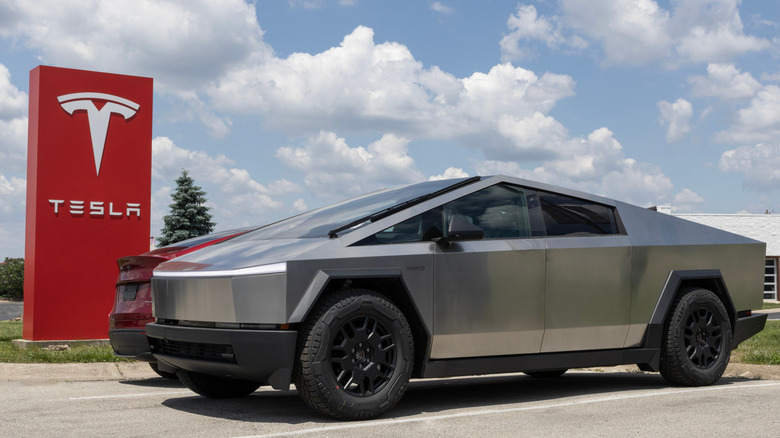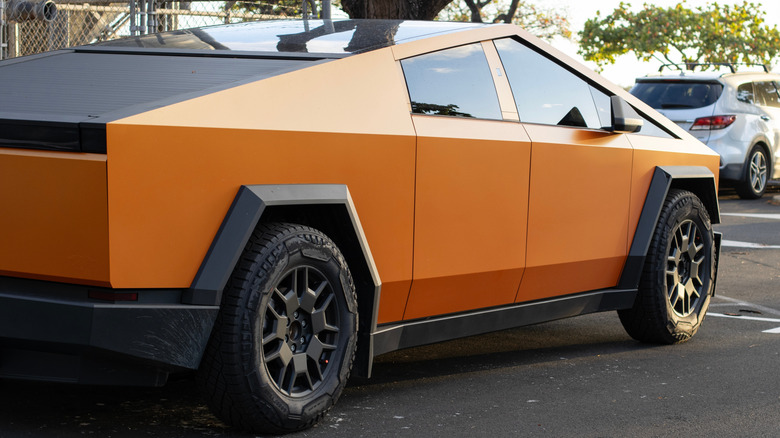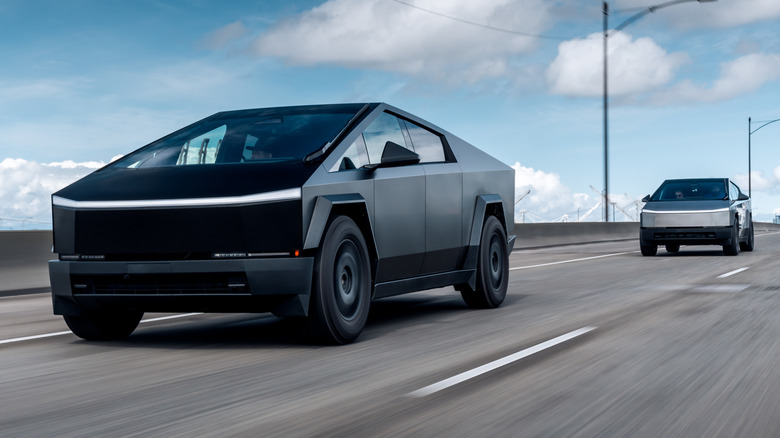Every Cybertruck Recall Tesla Has Issued In 2024
The Cybertruck hasn't been available for very long, in the grand scheme of things. The pickup was first shown off by Tesla boss Elon Musk in November 2019, and it wasn't until that very month four years later that it began to be available to drivers. It's fair to say that the Cybertruck turned heads across the auto industry when it was unveiled, for better and for worse, and is the EV brand's most fascinating product to date.
Much has been made of the vehicle's unique look – which Muskdescribes as "cyberpunk," according to CNBC – as well as just how "bulletproof" the Cybertruck really is. More important than its angular appearance, though, is the question of how well it has performed during its first full-year-and-a-bit in production. No new product is infallible, but given the high profile of Tesla and the media furor that this eye-catching model inevitably whipped up, the Cybertruck recalls the brand has issued have been particularly notable.
As of November 2024, a total of six Cybertruck recalls have been deemed necessary, each for a different issue identified with certain vehicles. Let's run down each of these recalls and exactly what it was for. To do this, we'll be referring to the National Highway Traffic Safety Administration's timeline of Cybertruck recalls.
2024's first Cybertruck recall: January's font-size snafu
Tesla's angular behemoth almost made it a full month into 2024 without any recalls being issued. The first struck on Jan. 30, and was about an unusual issue: font size.
Almost universally in the auto industry, there are important factors to warning lights: they need to be unobtrusive yet clear, visible and easy to understand when needed. This, unfortunately, was not the case with certain Tesla models. In 2024's Cybertruck — along with some Model X, Y, 3, and S Teslas — the NHTSA said the words on the instrument panel for the brake, park, and antilock brake system warning lights were too small.
A potential issue with the brakes is one of the most fundamental, dangerous faults a vehicle can experience, so it's crucial that the driver is alerted to the danger clearly and obviously. The other alarming aspect of this recall was how wide-reaching it was: In all, just short of 2.2 million Teslas – almost the entire U.S. repertoire – were recalled as a result.
Tesla acknowledged three warranty claims related to the issue, though no injuries or deaths. The company started a program of free updates to ensure the vehicles complied with the federal motor vehicle safety standards for brake systems.
2024's second Cybertruck recall: April's over-eager accelerator pedals
The brake, of course, is one of the components the driver needs to remain in complete control of. Another, as anyone who's been caught in a troublesome traffic jam (which is everybody) will tell you, is the accelerator. Almost three months after the first recall, April 17 brought the second one.
This was the first issue that affected only the Cybertruck, so it was far less widespread than January's problem. In this case, 3,878 vehicles were recalled. This isn't to say, though, that the issue that had to be addressed was any less pivotal, since safety is of paramount concern with any vehicles, even one that has survived all the impressive damage tests the Cybertruck has. The NHTSA described the fault: "The accelerator pedal pad may dislodge and cause the pedal to become trapped by the interior trim."
Tesla again responded to the notice with a free solution, promising to repair or replace the accelerator pedal assembly. The company added that it was a quick fix that could be implemented by its Mobile Service technicians — where possible — within a quarter of an hour.
2024's third Cybertruck recall: June's potentially faulty windshield wiper
It's possible to take the humble windshield wiper for granted. Indeed, if you rarely drive in the rain or other tricky weather and you clean your windshield fastidiously, you might not often need to deploy your wipers. The issue of visibility in inclement conditions can make them a matter of life or death, however, so June 2024 saw another Tesla recall for that very reason.
The Cybertruck boasts a lone wiper on the windshield, and quite a hefty one at that. This mighty blade had a possible issue, though, and it was potentially present almost all of the 12,000 Cybertrucks that had been sold by then. The wiper's motor could become overloaded and stop working, preventing the unwary driver from activating it. How much electricity is too much electricity for an EV? This much, it would seem.
Futuristic as the cybertruck may look, it's got to have all the fundamental functionality of an auto of today, and windshield wipers are about as fundamental as it gets. In October, Tesla sent an Important Safety Recall letter to affected Cybertruck owners explaining that the motor's gate driver was at fault for the potential problem, and that customers could arrange a free half-hour service to have it replaced.
2024's fourth Cybertruck recall: June's loose trunk-bed component
There are a lot of hazards on the roads that drivers need to be constantly wary of: puddles, potholes, pedestrians, and scores more that don't fit neatly into this alliterative format. The very last thing a driver wants to do is cause further obstructions, especially entirely unnecessary ones that could occur when fellow road-users least expect it. This, alas, was the situation Tesla faced in its second recall of June.
The issue this time around concerned the trunk-bed trim's sail applique, a part of which could come loose from the rear of the vehicle. Some 12,150 Cybertrucks may have been prone to this problem, though it was detected in only a few cases since Tesla first identified it at the end of 2023. The reason for this situation was that the applique's adhesion might have been improperly applied, so it might come loose and fly into the street.
The solution the company offered was, first, shiny new applique for Cybertrucks that were missing it. This alone wouldn't prevent a possible recurrence, of course, and so the other step was to ensure coverage of the pressure-sensitive tape with adhesion promoter. The Cybertruck has a lot of cool features, but it's essential that they all stay where they're supposed to be.
2024's fifth Cybertruck recall: September's delayed picture from the rear camera
Reversing isn't a lot of drivers' favorite maneuver at the best of times. Visibility and concentration are keys. Issues with the display of the rear camera essentially take away the driver's critical vision, and a fault with just that was registered in the fifth Cybertruck recall of 2024.
The issue, which the NHTSA said potentially affected '24 Cybertrucks "operating with a specific software logic for low voltage hardware," could result in a problem that meant the feed took six to eight seconds to display on reversing, which was up to four times longer than the standard two seconds. This could occur because reversing could interrupt the vehicle's processes, the report went on, "before the vehicle system completes its shut down and boot-up."
The dangerous implications of this are obvious, despite the fact that only a small number of Cybertrucks (approximately 1% of the 27,185 on the road by then) were believed to be subject to the problem. Nonetheless, it was a risk that the company couldn't take. For this voluntary fix, Tesla used a tool car manufacturers of old could scarcely have imagined: an over-the-air firmware update.
2024's sixth recall: a potential loss of drive power
In November of 2024, another potential Cybertruck issue arose. Some 2,431 Cybertrucks, the NHTSA reported, had been identified as possibly being subject to a problem that could unexpectedly result in a sudden dearth of drive power.
The part potentially at fault was the drive inverter. It's a component that has a vital job to do in an EV, "inverting" the DC power it receives from the vehicle's battery into a sweet, sweet supply of AC power for the motor, a bit like a photosynthesising plant. An interruption in this process can result in the reported loss of drive power.
The Teslas that may have been affected were those '24 models that had a particular part called a metal-oxide-semiconductor field-effect transistor in their inverters. The Cybertruck wouldn't alert the driver that this was about to happen, Tesla said, but once it did happen, drivers would get a visual alert. At that point, they should park and contact the company's Roadside Assistance unit.
Tesla had another free fix to handle then. This was quite the complicated one: Swapping out the driver inverter is a job that takes approximately three hours.






